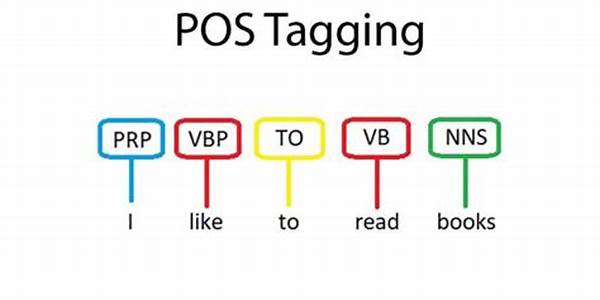Natural Language Processing (NLP) is a rapidly evolving field that bridges the gap between human language and computational technology. One of the foundational elements in NLP is Parts of Speech (POS) tagging, a process that involves assigning grammatical labels to each word in a sentence. However, the essence of effective POS tagging lies in contextual analysis. The purpose of this article is to explore the profound impact that contextual analysis has on POS tagging, how it enhances the tagging accuracy, and the innovative strategies being developed to propel this synergy forward. Armed with this understanding, businesses, developers, and linguists can leverage more sophisticated language models, improving interactions and communications with machines.
Embarking on the journey of contextual analysis in POS tagging might resemble learning a new language—a unique blend of logic, linguistics, and computational prowess. The basic principle is simple: understanding a word’s role in a sentence is influenced heavily by its surrounding words. For instance, the word “bank” could signify a financial institution or the side of a river, and the context clarifies which is correct. Cutting-edge algorithms, underpinned by this concept, are what make digital assistants like Alexa or Siri comprehend and interact in human-like manners.
The importance of contextual analysis in POS tagging can’t be overstated. Without considering context, the tagging would often be inaccurate, leading to misunderstood sentences and frustrated users. This is where words meet numbers, and linguistics becomes a playground for Artificial Intelligence (AI). Researchers highlight that employing machine learning models that factor in context distinguishes top-tier computational linguists from novices. It’s a game-changer, driving forward the promise of seamless human-computer interaction.
With businesses increasingly adopting AI-driven technologies, contextual analysis in POS tagging offers a secret sauce for enhanced consumer experiences. Imagine a personal assistant that not only responds but understands and anticipates needs. This is no longer the stuff of science fiction; it’s an evolving reality fueled by innovative contextual analysis strategies. As research delves deeper, this symbiosis between language processing and contextual understanding marks a new dawn in digital communication technology, one dense with potential and opportunity.
The Magic of Context
Indeed, the magic lies in the context—a defining factor that ensures machines read sentences like a human. Armed with historical data, advanced models predict and deduce the nature of relationships between words, translating to more accurate interpretations. The innovation is unmistakable, and so are the results—a revolution in understanding narratives, executing tasks more intuitively, and ultimately, redefining human interaction with machines.
—
Introduction to Contextual Analysis in POS Tagging
To unravel the complexities of contextual analysis in POS tagging, one must first dive into the nuances of language processing. Imagine teaching a computer to understand Shakespeare or a modern-day blog post—both herculean tasks lest we forget the power of POS tagging supported by contextual clues. It’s not merely about labeling words; it’s about embedding understanding into the machine language.
Machines, inherently, lack understanding. Yet, through intricate programming and learned models, they mimic human intuition. This mimicry is the result of years of research, hospitality by AI-friendly environments, and a persistent commitment to pushing communicative boundaries. It’s akin to teaching an orchestra to play symphonies—not through notes alone but through feeling, expectation, and the seamless integration of ensemble cues.
Moreover, as the digital landscape becomes more interactive, the need for precise POS tagging that takes context into account becomes apparent, impacting everything from voice-activated devices to complex data analysis tools. Visionaries in tech understand that a conversation with a machine should flow naturally, an ideal that is fast becoming reality with contextual analysis in play.
The Role of Contextual Analysis in Enhancing NLP
In crafting a more intelligent and responsive linguistic model, contextual analysis in POS tagging serves as the backbone. It equips machines with the ability to interpret and react, a testament to the futuristic vision of seamless machine-human dialogue that embellishes our gadgets and applications today.
Elevating Technology through Linguistics
Looking at statistics, data suggests dramatic improvement in user satisfaction when tech firms implement robust POS tagging systems. It underscores a fascinating intersection of linguistics, technology, and user experience, reiterating the power of contextual analysis to revolutionize communication. Companies investing in these innovations stand on the brink of technological evolution, harnessing progress that is both creative and analytical.
—
Discussion Points on Contextual Analysis in POS Tagging
Exploring the Core Benefits
Delving into the realm of contextual analysis in POS tagging transforms the abstract into the achievable, unraveling how machines can adapt to and predict language patterns with mind-boggling accuracy. At first, it seems like the centerfold of a sci-fi novel until one realizes the tangible results that spring from dedicated research and technology application. Through strategic integration of contextual analysis, machines become more than mere processors—they evolve into companions.
This evolution doesn’t just serve technology companies. From better customer service to improved accessibility features for those with disabilities, the societal impact is immense. Enhanced understanding between man and machine could remove barriers in communication, offering equitable tools for more significant innovations and adaptations.
More practically, the tech-savvy businesses that integrate contextual analysis into their processes find competitive advantages, boosted user experiences, and enhanced service delivery leading to impressive returns on investment. This is not merely an academic pursuit; it’s a convergence of need, solution, and potential.
Integrating Contextual Analysis in Daily Operations
With each technological stride, the boundaries blur—where does humanity end and the machine begin? Contextual analysis in POS tagging is a key player in this narrative, its relevance undeniable as it continues to illuminate the path forward for companies keen to embrace all that modern NLP technology has to offer.
Unlocking Possibilities
Imagine a world where misunderstandings between user interface and human impression are reduced to nil. Embracing the full potential that contextual analysis in POS tagging promises means walking towards a harmonized digital symphony where everything sounds just right. The opportunities? Endless. The journey? Just begun. The potential for transformation? Revolutionary.

